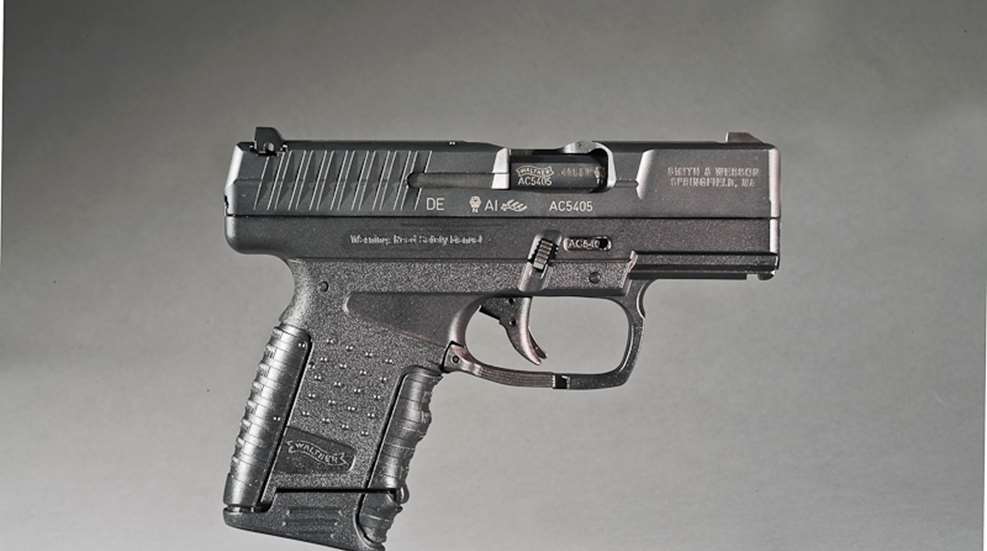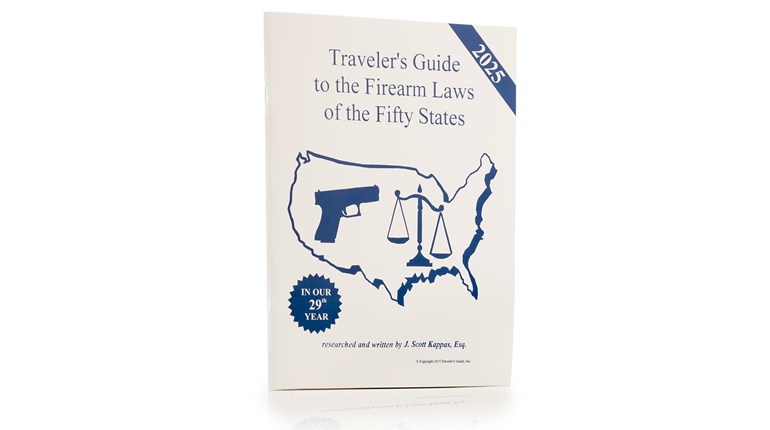
When I was growing up, guns—all guns—were supposed to be good looking. Good looks are subjective, but in the '70s a good-looking gun had high-polished steel and a finely figured wood stock. In the 1973 film "Electraglide in Blue," Robert Blake played motorcycle cop John Wintergreen and his service weapon was a two-tone Colt Python. It's been 36 years and I still want a two-tone Python.
Just like dad told me about girls and guns a long time ago, "Looks ain't everything, son." A gun that won't go bang every time you pull the trigger, or one that's too heavy to have with you when a bad cloud blows over isn't of much use. The first thing I thought when I looked at the Walther PPS was: That's one ugly gun.
To me, the Walther PPS looks like something from a James Bond movie. It's thin and compact, black and covert with a utilitarian, mean appearance. I can see a secret operative brushing his tuxedo jacket to the side and whipping one of these pistols out while stepping between a dark-haired Italian beauty and one of SPECTRE's henchmen. Bond carried a PPK, another Walther, in the movie "Dr. No." He would have been much better armed with a PPS.
Slimness helps make a handgun concealable and easy to carry. This is one reason the Walther PPK is such a popular deep-cover handgun; it's only 0.98 inches wide. Guess what? The Walther PPS is even thinner.
The PPS' size is similar to a Glock 26 and a Springfield XD Subcompact, but it is noticeably slimmer than both. Magazine capacity is the difference. The Springfield and Glock utilize a double-stack magazine. The PPS uses a single-stack magazine. The wider pistols hold 10 rounds and the PPS holds between 5 and 7, depending on the magazine floorplate used. Extra ammunition is great, but not if it alerts other secret agents or criminals to the fact you have a gun when undercover.
An important consideration when selecting a concealed carry handgun should be magazine capacity. But, it should not come before concealability or ease of carry. That's where the .40 S&W PPS is positioned in the marketplace. It offers a lot of power in an easy-to-carry package that's thinner and lighter than the legendary PPK. If your handgun is hard to conceal, or uncomfortable to carry, it will be under the seat of your car or at home on the nightstand when you really need it.
The PPS is a recoil-operated, striker-fired semi-automatic handgun built with a steel encased, polymer frame and a steel slide. It's Glock-like with its dual, captive recoil springs, modified linkless Browning-like barrel, Tenifer finish and safety lever in the center of the trigger that must be depressed to allow the gun to fire. A magazine disconnect is optional and there is no manual safety. The only external levers, buttons or switches are the slide lock and takedown levers.
Field stripping the PPS is sixth-grader simple. Remove the magazine, clear the chamber, pull the trigger, push down on the takedown levers and pull the slide off. Press your thumb against the recoil spring-guide assembly and it pops right out allowing barrel removal. Field stripping allows cleaning and access to the PPS' six lubrication points, which Walther suggests be treated routinely with a high-quality firearm lubricant. To reassemble, install the barrel, recoil spring-guide assembly and slide.
At some point, every handgun gets compared to a 1911, so we might as well get that out of the way. One thing that makes a full-size 1911 so comfortable and controllable is the even distribution of weight between the frame and slide. Add a full magazine of ammunition and most of the weight of a 1911 is under the barrel. That's not so with today's popular, polymer-frame handguns, including the PPS. The frame of the PPS is 29 percent of the total gun weight when empty. That's the tradeoff you make for being able to tuck a 19-ounce, .40-caliber handgun in your pocket.
The PPS has a Picatinny accessory rail on the frame just forward of the trigger guard to allow mounting a laser or light, and it comes standard with three-dot sights. The rear sight is drift adjustable for windage and the front sight is fixed. According to the owner's manual, optional front sights of varying heights are available and can be changed by the owner with a screwdriver to help match point of aim with point of impact. The test gun shot perfectly to point of aim at 25 yards.
The owner's manual also has several warnings. Actually, more than any manual I've seen for any firearm. That's not a bad thing; most deal with general firearm safety but another instructs, "Use only commercially manufactured ammunition with internal ballistic pressures which are in strict accordance with the specification of the Sporting Arms and Ammunition Manu-facturers' Institute (SAAMI)."
There's also a warning about +P ammunition that states, "Such pressures may affect the wear characteristics of your PPS pistol." With regard to +P+ ammo the manual is very specific, "Plus-P-Plus (+P+) ammunition must not be used in Walther firearms." I'm OK with all that. I would not want to shoot either type of ammunition in such small, lightweight .40 S&W pistol anyway.
The PPS also has loaded-chamber and cocked indicators. If you look down on the top of the handgun you'll see a small, rectangular cut in the rear of the chamber. If there is a round in the chamber you can see the cartridge case through this window. I also found you could run your trigger finger over the extractor on the right side of the slide and feel minimal protrusion when a round is in the chamber. The cocked indicator is a red button on the rear of the slide that allows you to verify the striker's status.
There are two additional features that deserve attention. The first is the ambidextrous magazine release. Traditionalists will be turned off by the departure from the frame-mounted, thumb-push button so common on American-made semi-automatic handguns. I used to have the same prejudice, but have learned not to judge things based on conventional wisdom. Rather, I base my verdict on how they work. The lever-hinged magazine release on the PPS is at the junction of the frame and the bottom of the trigger guard, extending about 1.2 inches along either side. It can be actuated ambidextrously. I like it and suspect those who give it an honest try will as well.
An exciting new attribute is the removable QuickSafe Safety backstrap. Interchangeable backstraps you can select to fit your hand are cool, but not new. However, one that will leave the handgun inoperable when removed, is. There is a small tab located at the bottom of the backstrap, at the rear of the magazine well. Push this tab in and the backstrap easily slides off. Without the backstrap, the PPS will not fire.
Accuracy from the bench at a distance of 25 yards was as expected from a handgun with 2 inches of rifling and a sight radius of 5.3 inches. It was more than sufficient for a personal-protection handgun, and I managed to hit a 10-inch steel plate at 40 yards nine out of 10 times from a standing, two-hand hold. That's all well and good, but what matters is how a handgun like this performs in practical situations, like during rapid-fire adrenalin dumps at close range or when executing double taps.
I fired six shots from 7 yards twice in less than two seconds using a two-handed, isosceles stance. Only one of the 12 shots landed outside the 9-ring on a B-27 target. I did the same drill three times using only my strong hand with an average time of less than four seconds and managed to keep 14 of the 18 shots inside the 9-ring. I also conducted 10 double-taps at 7 yards using a two-hand hold and 17 of the 20 shots landed inside the 9-ring.
One concern with all short-barreled defensive handguns is velocity. Sometimes snubby guns will not develop sufficient velocities for defensive handgun bullets to reliably expand during penetration. No worries here; based on expansion tests I have conducted, all bullets left the PPS with sufficient velocity to expand at reasonable defensive-handgun engagement distances.
The little gun is controllable but has a bite, even with the 155-grain Hornady loads. The stippled grip provides good purchase, but your hand will know it has hold of something with an attitude. I didn't find the recoil objectionable or surprising, after all this is a 20-ounce .40 S&W. I would not, however, suggest this gun to a new or inexperienced shooter. With the thinnest backstrap my wife said the PPS "felt good," then she pulled the trigger, made it go bang and changed her mind.
Ugly we've covered. What about the good and the bad? Every time I pulled the trigger on the PPS, the gun went bang, an empty case was ejected and a fresh cartridge was chambered until the magazine was empty. I tried to induce jams, but could not. It was 100-percent reliable in the feeding and ejection department and more than sufficiently accurate to fill a personal-protection role. Six rounds of .40 S&W into the torso of a bad guy at 7 yards in less than two seconds should be a fight stopper.
The PPS is incredibly easy to conceal. It slid right inside the deep, rear pocket of my EOTAC jeans and didn't leave a print. The great thing about a gun this thin is it opens a multitude of concealable and comfortable carry options not so enjoyable with thicker handguns. The interchangeable backstrap feature is another comfort-minded option that also provides a unique way to easily and quickly render the handgun inoperable.
The first "bad" has to do with the trigger. Though the pull was of a moderateweight—measuring 5.4 pounds on my Timney trigger pull gauge—you could feel the mechanism working during the pull. From the bench and during off-hand slow fire, it was noticeable. During speed drills and practical exercises it was not. I can't imagine it negatively impacting your shooting in a real-world situation, but it might be annoying to some during slow fire.
The second "bad" had to do with the magazine/slide lock. I fired 200 rounds, which amounted to 37 magazines (some were not fully loaded). On 13 of those 37 instances, the slide failed to lock back after the last round fired. Apparently this was not an ammo issue, because it occurred at least once with each load tested. This is usually a sign of a magazine problem, but I could not verify it because the PPS is only shipped with one magazine. Extra magazines are available and have a suggested retail price of $57.
Beyond that, one concern shooters looking for a carry gun should have is the availability of holsters. There are not a lot of holsters for the PPS, but there are some good ones and even though pocket carry is a reasonable option with this pistol, good gun leather is always a better and safer option. DeSantis makes quality carry gear at a reasonable price and offers several holster and carry options for the PPS.
For some of us and some guns, ugly is a fact of life. The PPS might be ugly in looks but it's beautiful in function and practicality. It may not be a two-tone Python, but it's lighter, thinner, less expensive and much more concealable. Based on the handguns I have experience with, the PPS is the most concealable semi-automatic .40 S&W currently available. For that, I'll live with a little ugly.






































